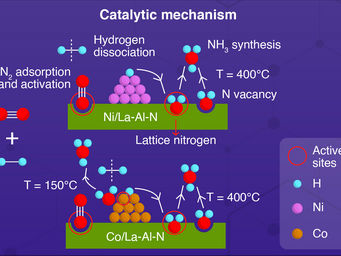A green approach to making ammonia could help feed the world
Advertisement
A UCF research team with collaborators at Virginia Tech have developed a new "green" approach to making ammonia that may help make feeding the rising world population more sustainable.
"This new approach can facilitate ammonia production using renewable energy, such as electricity generated from solar or wind," said physics Assistant Professor Xiaofeng Feng. "Basically, this new approach can help advance a sustainable development of our human society."
Ammonia, a compound of nitrogen and hydrogen, is essential to all life on the planet and is a vital ingredient in most fertilizers used for food production. Since World War I, the ammonia in fertilizer has been primarily produced using the Haber-Bosch method, which is energy and fossil-fuel intensive. There have been substantial obstacles to improving the process, until now.
The biggest obstacle to ammonia synthesis is the high energy barrier to activate nitrogen molecules. In order for the chemical process to hit a high reaction rate, nitrogen and hydrogen molecules must be heated to high temperatures under a pressure with the presence of iron-based catalysts.
There are many efforts to pursue ammonia synthesis under milder conditions, and one of them is to use electrical energy. In an electrochemical method at room temperature, active electrons are used to drive the reaction with water as the hydrogen source, but the electrons passing through an electrode cannot be efficiently used and the reaction rate is very low.
"Our research discovered a new mechanism whereby electrons can be more efficiently used via the catalyst of palladium hydride. This new approach may not only provide a new route for ammonia synthesis with minimal electrical energy, but also inspire peer researchers to use the principle to address other challenging reactions for renewable energy conversion, such as turning carbon dioxide into fuels," Feng said.
Co-author Hongliang Xin, an assistant professor at Virginia Tech, said there is so much more to discover in this new area of research.
"This is a very exciting research for converting nitrogen to ammonia at room temperature. Quantum chemical simulations have suggested a unique reaction pathway for the palladium catalyst with a lower energy barrier," Xin said. "However, the detailed mechanism, particularly its competition with electron-stealing hydrogen evolution and effect of operating voltage, is still largely unknown."
Original publication
Jun Wang, Liang Yu, Lin Hu, Gang Chen, Hongliang Xin & Xiaofeng Feng; "Ambient ammonia synthesis via palladium-catalyzed electrohydrogenation of dinitrogen at low overpotential"; Nature Comm.; 2018
Other news from the department science
Most read news
More news from our other portals
See the theme worlds for related content
Topic world Synthesis
Chemical synthesis is at the heart of modern chemistry and enables the targeted production of molecules with specific properties. By combining starting materials in defined reaction conditions, chemists can create a wide range of compounds, from simple molecules to complex active ingredients.

Topic world Synthesis
Chemical synthesis is at the heart of modern chemistry and enables the targeted production of molecules with specific properties. By combining starting materials in defined reaction conditions, chemists can create a wide range of compounds, from simple molecules to complex active ingredients.

































































